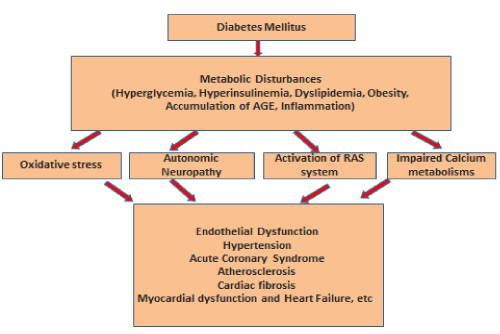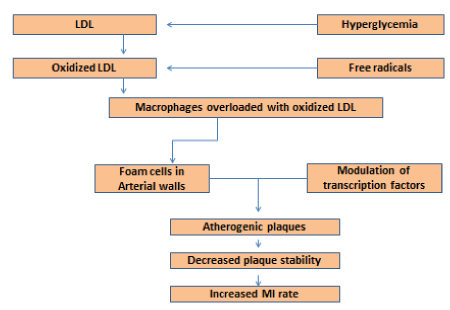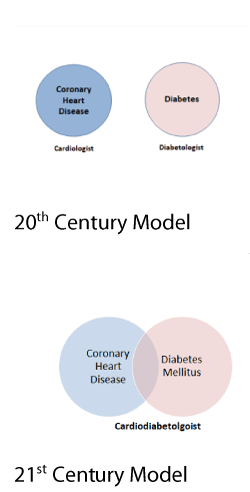Journal of Cardiovascular Medicine and Cardiology
Cardio-diabetology: New subspecialty and collaborative work to defeat the burden of deadly duo
Han Naung Tun1,2,3*
2Clinical and Research Working Groups, European Society of Cardiology, Myanmar
3National Representative of the Heart Failure Specialist of Tomorrow (HoT) for Myanmar in European Heart Failure Association, European Society of Cardiology, Myanmar
Cite this as
Tun HN (2018) Cardio-diabetology: New subspecialty and collaborative work to defeat the burden of deadly duo. J Cardiovasc Med Cardiol 5(4): 081-084. DOI: 10.17352/2455-2976.000077Cardiovascular disease (CVD) is one of the most global threatened diseases; particularly coronary artery disease (CAD) is a major deadly attack around the world. Diabetes mellitus (DM) is associated with a 2 to 4-fold increased mortality risk from heart disease. Diabetes related microvascular complication is seemed to be a hazardous factor for cardiovascular system and likely to cause coronary arteries disease, hypertension, peripheral arteries, and carotid vessels, especially seen in the type 2 DM populations. The severity of cardiovascular complications are related to prolong hyperglycemia and the control of dysglycemia. Thus, effective glycemic control is one of the imperative aspects of the management for the prevention of CVD in diabetes. In addition, different kinds of antidiabetes agents have different mechanism of actions that has impacted to cardiovascular outcome. The benefit and risk of current anti-diabetic agents are needed to define clearly and that is needed to promote effective clinical care between cardiology and diabetology. There are multiple complications and sequelae of diabetes that requires the involvement of cardiologic expertise in the diabetes care setting in heart disease population. Therefore, the close cooperation between the cardiologist and the diabetologist is new perceptive way of care to defeat diabetes related cardiovascular complications.
Introduction
Diabetes mellitus (DM) is one of the most prevalent and health burdensome of global health problems in the 21st century. DM is a major risk factor for cardiovascular disease (CVD), which is the most common cause of death among adults with DM. People living with diabetes have increased from 108 million in 1980 to 422 million in 2014 [1]. Up to about two third of patients age 65 or older with diabetes die from some form of heart disease; and 16% die of stroke.
Adults with diabetes are two to four times increased risk of heart attacks and strokes, which seems to be more likely to die from heart disease than adults without diabetes [2]. Therefore, Diabetes is a major burden to global health care system. Although improving therapies and varieties of available oral hypoglycemic agents to treat DM in recent years, it’s still related to some form of cardiovascular complications and its hospitalization numbers are increasing. Thus, prevention and long-term care are very importance in respond to the increasing prevalence.
Association of diabetes mellitus and cardiovascular disease
The strong interaction between diabetes and cerebrovascular incidents are well established. Since both of them have similar risk factors such as older age, overweight and obesity, unhealthy diet, physical inactivity, sedentary lifestyle and smoking, the development of the one may exacerbate the another one between type 2 DM and CVD. The overlapping areas of diabetology and cardiology are being now focused to do many studies and trials to understand more about the point of care in diabetes patients in cardiovascular disease populations. Both type 1 and type 2 DM have potential systemic pan-inflammation that leads to cause vascular damage. The well-recognized microvascular complications of DM is a group of silent killers including coronary arteries disease, hypertension, peripheral arteries, and carotid vessels, especially seen in the type 2 DM populations [3]. Accordingly, acute coronary syndrome and vascular infract patients frequently have pre-existing diabetes or metabolic disorders , that may or may not be diagnosed at the time of vascular incident. The basic mechanism of diabetes leading to cardiovascular disease is shown in figure 1.
Hyperglycemia, dysglycemia, hypoglycemia and cardiovascular complications
Atheroma formation is the major underlying pathological process to atherosclerosis. The atheroma in diabetes tends to be diffuse and progress more rapidly than in the non-diabetes group. Inflammation and insulin resistance are both very important factors in the acceleration of macrovascular disease. Hyperglycemia is a contributing factor that exacerbates the atherosclerosis process by changing vascular smooth muscle cell, platelet function and alteration of the endothelial function is tended to be induced decrease in endothelium-derive nitric oxide, which plays protective role in causing vasodilatation [4]. The mechanisms of hyperglycemia induced oxidized LDL leads to myocardial infarct is shown in figure 2. Multiples studies have shown that hyperglycemia may have a detrimental effect on the ischemic myocardium. Hyperglycemia is likely to promote ischemic precondition impairment, expend infarct sixe, higher incidence of the no-reflow phenomenon, elevated catecholamine levels, prothrombotic state and increased oxidative stress and inflammation [5]. Thromboembolic cerebrovascular events and peripheral vascular disease occur in up to about 10 % of patients, with a two-fold increased risk compared to non-diabetes populations [6].
In addition, the occurrence and severity of cardiovascular complications are related to the control of dysglycemia. There are several clinical trials that have been done focusing on the role of intensive glycemic control in the prevention of cardiovascular disease (CVD) in diabetes. The meta-analysis result from the large clinical studies included UKPDS (United Kingdom Prospective Diabetes Study), ACCORD (Action to Control Cardiovascular Risk in Diabetes Trial), ADVANCE (Action in Diabetes and Vascular Disease: Preterax and Diamicron MR Controlled Evaluation trial), VADT (Veterans Affairs Diabetes Trial) and PROactive (pioglitAzone Clinical Trial In macroVascular), shows that there is 17% decrease in nonfatal myocardial infarct and 15% decrease in coronary heart disease events [7]. Thus, effective glycemic control is one of the robust parameter for the prevention of CVD in diabetes.
Different kind of anti-diabetes drugs, insulin and CVD
When it comes to treat diabetes patients with heart disease, it is an imperative thing to know the safety of oral hypoglycemic agents is chosen. Multiple new medications for glycemic management of type 2 diabetes have recently been recommended by evidence based clinical guidance. According to the number of data shows that patients hospitalized with heart failure and reduced ejection fraction has approximately 40% of diabetes mellitus [8]. When it comes to deal with diabetes and heart care, cardiologists, diabetologists or endocrinologists, and general and primary care physician should weigh cardiovascular and other risks against the potential benefits when prescribing medications. (United Kingdom Prospective Diabetes Study (UKPDS) shows that it increased CV mortality. Preterax and Diamicron MR Controlled Evaluation (ADVANCE) and Action to Control Cardiovascular Risk in Diabetes (ACCORD) trials, in which sulfonylureas were highly represented in the intensive glucose-lowering arms, no increased CV risk was reported by the investigators [9]. After Stroke (IRIS) trial and Prospective Pioglitazone Clinical Trial in Macrovascular Events (PROActive) trial and with pioglitazone shows reduce risk of MI and stroke. But it increases HF hospitalization and contraindicated in patients with or at risk of HF [10]. Recent large meta-analysis including Saxagliptin Assessment of Vascular Outcomes Recorded in Patients with Diabetes Mellitus–Thrombolysis in Myocardial Infarction (SAVOR-TIMI 53) trial and Examination of Cardiovascular Outcomes with Alogliptin versus Standard of Care (EXAMINE) has confirmed a 25% increase in HF hospitalizations related to DPP-4 inhibitors [11]. In observational studies in HF, insulin was associated with higher mortality rates than metformin [12].
Metformin, incretin-based therapies including glucagon-like peptide-1 receptor agonists and Dipeptidyl peptidase-4 inhibitors have potential positive effects on the cardiovascular system when compared to sulfonylurea, thiazolidinedione and insulin [13]. Sodium glucose co-transporter 2 inhibitors are new novel oral glucose-lowering agents though, the potential for cardiovascular benefits particularly in heart failure. However, there are still some arguable facts and limited data on cardiovascular safely of some oral hypoglycemic agents and large RCT are still needed [14]. Therefore, it is important to clearly define the benefit and risk of current anti-diabetic agents and needs to get more collaborative work between cardiology and diabetology.
Diabetologists or endocrinologists in cardiovascular care
Coronary heart disease (CHD) is the one of most common dangerous complication and cause of high mortality among patients with diabetes. Many patients with diabetes have unrecognized coronary artery disease (CAD), which is associated with silent myocardial ischemia. The main problem to tackle in diabetes care is to detect silent myocardial ischemia. Nowadays, there are varieties of method being proposed for screening patients for asymptomatic CAD. They include exercise treadmill ECG test (TMT), stress echocardiography, stress myocardial perfusion imaging, CT angio with CT coronary calcium scoring, CT angiography, Cardiac MRI and Cardiac PET. Each of them has different sensitivity and specificity to screen myocardial ischemia. Investigators from DIAD (The Detection of ischemia in Asymptomatic Diabetes) study evaluated whether routine screening for CAD influences ultimate cardiac outcomes [15]. Other complication is the diabetes induced myocardial injury identified as diabetic cardiomyopathy .The prevalence of diabetic cardiomyopathy is increasing in parallel with the increase in diabetes mellitus [16].
In the setting of diabetes care in heart disease population, there are multiple complications and sequelae of diabetes that require the involvement of cardiologic expertise. Monitoring and immediate response to diabetes induced microvascular and macrovascular complications particularly in acute myocardial infarction is the main purpose of the cardiovascular expertise and diabetologist collaborative care treatment that is a corner stone in modern diabetes care and that substantially contributes to improved outcome. Beside neuroendocrine activation in diabetes also inflammatory immune response may trigger multiple pathways resulting together in a range of cardiac complications including plaque instability, calcium overload, blood pressure peaks, endothelium dysfunction, microcirculatory failure, and electrical instability. According to a meta-analysis including all randomized trials, the investigators reveled screening asymptomatic diabetes patients for CAD with myocardial ischemia is not mandatory. Although not all of these patients require immediate (invasive) cardiovascular diagnostic workup, the number of patients with a culprit coronary lesion has been reported to be screened is better outcome [17]. It therefore requires consequent and qualified cardiologic involvement to decide the further diagnostic and therapeutic path in twenty first Century (Figure 3).
Conclusion
Because of the diabetic coronary patient is particularly vulnerable with respect to his vessels, his blood and his myocardium ,a close cooperation between the cardiologist and the diabetologist is in the best interest of the patient. Again, a close cooperation between diabetologist and cardiologists is required to coordinate these appropriated diagnostic measures and provide effective care to combat the burden of the deadly duo.
- Mathers CD, Loncar D (2006) Plos medicine, Projections of global mortality and burden of disease from 2002 to 2030. 3: e442. Link: https://goo.gl/b7vDaX
- Sarwar N, Gao P, Seshasai SR, Gobin R, Kaptoge S (2010) Di Angelantonio et al Diabetes mellitus, fasting blood glucose concentration, and risk of vascular disease: a collaborative meta-analysis of 102 prospective studies. Emerging Risk Factors Collaboration. Lancet 26: 2215-2222. Link: https://goo.gl/YrXMHz
- Beckman JA, Creager MA, Libby P (2002) Diabetes and atherosclerosis: epidemiology, pathophysiology, and management. JAMA 287: 2570–2581. Link: https://goo.gl/QErUQ1
- Creager MA, Luscher TF, Cosentino F, Beckman JA (2003) Diabetes and vascular disease. Pathophysiology, clinical consequences and medical therapy, Circulation 108: 1527-1532. Link: https://goo.gl/2SXTsj
- Deedwania P, Kosiborod M, Barrett E (2008) Hyperglycemia and acute coronary syndrome : a scientific statement from American Heart Association Diabetes Committee of the Council on Nutrition, Physical Activity , and Metabolism, Circulation 117: 1610-1619. Link: https://goo.gl/678uY2
- Wannamethee SG, Shaper G, Whincup P (2011) Impact of diabetes on cardiovascular disease. Risk and all-cause mortality in older men. Ach Intern Med 176: 404-410. Link: https://goo.gl/Lnu72J
- Ray KK, Seshasai SR, Wijesuriya S, Sivakumaran R, Nethercott S, et al. (2009) Effect of intensive control of glucose on cardiovascular outcomes and death in patients with diabetes mellitus: a meta-analysis of randomised controlled trials. Lancet 373: 1765-1772. Link: https://goo.gl/iS5Df9
- Kumar R, Kerins DM, Walther T (2016) Cardiovascular safety of anti-diabetic drugs ,European Heart Journal - Cardiovascular Pharmacotherapy 2: 32-43. Link: https://goo.gl/SAqMnw
- Action to Control Cardiovascular Risk in Diabetes Study Group, Gerstein HC, Miller ME, Byington RP, Goff DC Jr, Bigger JT, et al. (2008) Effects of intensive glucose lowering in type 2 diabetes. N Engl J Med 358: 2545-2559. Link: https://goo.gl/gRKU7H
- Yki-Jarvinen H (2004) Thiazolidinediones. Engl J Med 351: 1106-1118. Link: https://goo.gl/4F9c1h
- Udell JA, Cavender MA, Bhatt DL, Chatterjee S, Farkouh ME, et al. (2015) Glucose-lowering drugs or strategies and cardiovascular outcomes in patients with or at risk for type 2 diabetes: a meta-analysis of randomised controlled trials Lancet Diabetes Endocrinol 3: 356-366. Link: https://goo.gl/tVo79H
- MacDonald MR, Petrie MC, Varyani F, Ostergren J, Michelson EL, et al. (2008) CHARM Investigators. Impact of diabetes on outcomes in patients with low and preserved ejection fraction heart failure: an analysis of the Candesartan in Heart failure: Assessment of Reduction in Mortality and morbidity (CHARM) programme. Eur Heart 29: 1377-1385. Link: https://goo.gl/KQSqoh
- Tun HN, Mazhar Quresh MW, Yambao EO (2018) “Metformin: A Novel Drug and Helper for Heart Failure with Type 2 Diabetes”. EC Cardiology 5: 871-878. Link: https://goo.gl/xSqtyJ
- James Xu, Rajaratnam R (2017) Cardiovascular safety of non-insulin pharmacotherapy for type Cardiovascular Diabetology 16: 18. Link: https://goo.gl/PpxVmi
- Wackers F, Young L, Inzucchi S (2004) Detection of silent myocardial ischemia in asymptomatic diabetic subjects. Diabetes Care 27: 1954-1961. Link: https://goo.gl/hGb7X9
- Guanghong Jia, Michael A, Hill, James R (2018) Sowers Diabetic Cardiomyopathy, Circulation Research 122: 624-638. Link: https://goo.gl/vRjjzA
- Miller T, Redberg R, Wackers F (2006) Screening asymptomatic diabetes patients for coronary artery disease. KJ Am Coll Cardiol 48: 761-476. Link: https://goo.gl/PyLV81

Article Alerts
Subscribe to our articles alerts and stay tuned.
 This work is licensed under a Creative Commons Attribution 4.0 International License.
This work is licensed under a Creative Commons Attribution 4.0 International License.



 Save to Mendeley
Save to Mendeley
